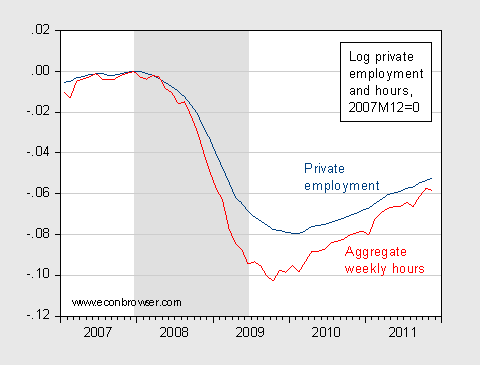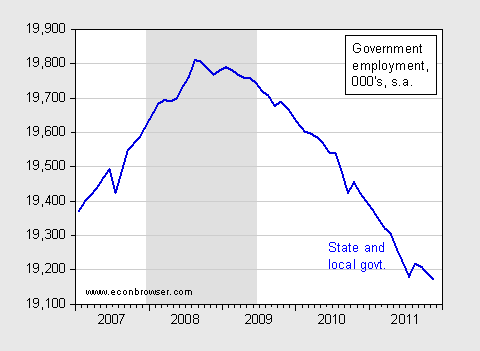Some good news, but it all has to be put in perspective. As Mark Thoma points out, 120,000 jobs is about what is needed to keep unemployment from rising. In addition, the drop in the unemployment rate was driven largely by the drop in the participation rate, not the rise in employed. That’s going to be greater relevance if the extension of unemployment benefits is further blocked (in other words, there are offsetting employment effects from UI, as discussed in this rejoinder to Mulligan). More discussion at Izzo/WSJ RTE. I’m going to focus on data from the establishment survey.
The main points:
- Nonfarm payroll, and the civilian employment series adjusted to conform to the NFP series both continue to rise, with the latter rising more rapidly.
- Aggregate weekly hours in the private sector continues to rise more rapidly than employment, but has not caught up.
- Total government employment continues to decline.
- Most of the decline in government employment is at the state and local levels.

Figure 1: Nonfarm payroll employment (blue), and civilian employment adjusted to conform to NFP concept (dark red), 000’s, seasonally adjusted. NBER defined recession dates shaded gray. Source: BLS via FRED, BLS, and NBER.
The difference between the experimental adjusted household-survey based series and the establishment series is now over 2 million (!), or 1.5% (log terms). Strangely, despite the fact that conservatives demanded the creation of this series, I have seen no commentary from those quarters remarking on this fact.

Figure 2: Log private employment (dark blue), and log aggregate weekly hours index in private sector, series AWHI (red), seasonally adjusted, rescaled to 2007M12=0. NBER defined recession dates shaded gray. Source: BLS via FRED, NBER and author’s calculations.
Aggregate weekly hours in the private sector continues to rise more rapidly than employment (haltingly), but has not caught up. The gap is 0.6%.

Figure 3: Government employment (red), and government employment ex.-temporary Census workers (blue), 000’s, seasonally adjusted. NBER defined recession dates shaded gray. Source: BLS via FRED, NBER and author’s calculations.

Figure 4: Government employment and state and local levels (blue), 000’s, seasonally adjusted. NBER defined recession dates shaded gray. Source: BLS via FRED, NBER and author’s calculations.
As shown, total government employment continues to decline, driven mostly by the decline in government employment is at the state and local levels. Since our children currently know everything they need to in order to find jobs and compete in the global economy, cutting teachers seems like a great idea. November employment in local government education is down 94,000 relative to a year earlier. As noted here, Wisconsin is working hard to be at the forefront of this trend!
Since our children currently know everything they need to in order to find jobs and compete in the global economy, cutting teachers seems like a great idea.
Such an opinion is usually held by someone who opposes merit-based evaluation and raises for teachers.
Perhaps if young people actually learned at school how to be functional, productive adults by age 14-16 to 18, including thoroughly understanding the division of labor, wealth and income distribution, personal finance and accounting (balance a checkbook, saving, etc.), the tax code, profit and loss, and skills required to be self-employed (networking, negotiating, partnering, etc., we would not need to waste so much money forcing young adults into universities and overpriced for-profit, post-secondary “education” they don’t need nor can afford, only for them to learn (and society to pay the price) that they didn’t learn anything useful, and it cost a fortune to learn it.
Secondary schools have become hardly more than high-priced babysitting for young adults, jobs programs for underachieving C (D accounting for grade inflation) students, and waystations for young adults to keep them out of the full-time labor force in order to reduce the unemployment rate.
Get rid of “diversity” and “self-esteem” nonsense and social engineering and put skilled “teachers” (get rid of educators educating educators to educate educators to educate) and practitioners in the classroom teaching useful, value-add polytechnical skills that 80-90% of students are going to use in the labor market.
There is no practical reason why a 16-18 year-old should not be able to receive a comprehensive occupational skills credential in one or more of dozens of real-world skills to prepare for entry-level employment, including accounting, computer programming/Web design, systems technician/network engineering/service, welding, carpentry and construction, auto and diesel service, medical assisting, nursing, permaculture, truck driving, retail management, and too many to list here.
And the schools should be designed and funded to offer lifelong reentry for retraining, much as community colleges are today. Consolidate the staffing, facilities, and funding into a post-secondary polytechnical and lifelong retraining and placement system.
Then increase admission requirements and cut funding significantly for state universities to the level at which only about 10% of students would qualify (instead of 40%) to attend and who are self-selected and prepared to actually excel at university-level work.
This would cause many to cringe as it seemingly offends our egalitarian sensibilities; however, were the secondary polytechnical and lifelong learning facilities well funded and fully functional as in Europe, producing skilled, employed graduates for the emerging labor market, I suspect few among the working-class masses the facilities would best serve would object. The biggest critics would likely be the bloated universities’ administrations.
As long as Mssrs. Hamilton and Menzies were able to keep their jobs in the UC and WI systems, they might even prefer such a situation, as it would mean teaching even fewer classes than they do now, grading far fewer papers, more time wasted on blogs with us dim types, supervising fewer grad students, and hand holding fewer anxious, depressed types in post-doc purgatory.
Dick: Yeah! And get rid of all arts education, for sure that yields no positive benefits. Just need those adding machines and strong hands to twist wrenches and dig trenches. And while getting rid of diversity, let’s go all the way — why not try eugenics? Brave new world, w/o any dullards! At long last, I finally know what world you desire.
By the way, it would be more correct to say “Mssr. Chinn”, rather than “Mssr. Menzies”.
OT:
I’d like to comment on the Egyptian elections, which various Islamic parties won by a landslide.
When dictatorships decay into democracies, as we see in Egypt, voters will tend to want to affiliate with people like themselves, which generally means of the same ethnic group or religion. We can see this process in the dissolution of the Hapsburg Empire, Yugoslavia, and Iraq, just to name a few.
When dictatorships fall, voters will tend to seek a government they perceive as representing better agency, and as we know, the ‘agent’ in principal-agent theory is by construction a conservative. Religious leaders or those espousing religious values will be seen as better representing the interests and values of the people. They will be viewed as superior agents, just as we saw in the early stages of the Iranian Revolution.
But theocracies often prove poor at governance and may revert to autocracy, again, with Iran as the example. This is undesirable to the west on both counts, which must now contend with both dictatorship and theocracy. From the point of view of the western democracies, we would prefer not to have to choose between democracy and religious fundamentalism. How to avoid this conundrum?
First, I think we have to accept it as natural that the broader population, if they are allowed free choice, will seek to be led by those with values similar to their own. At the same time, mechanisms can be put in place which act on the principal (the self-interest of the Islamic politician), rather than on the agent (forcing the government to accept an unpalatable western policy).
It is in the interest of the United States that Egypt should prosper and remain fiscally stable. Prosperity is not compatible with any of extremism, war, terrorism or repression. By encouraging the installation of performance-based incentives for all members of Egypt’s parliament, western governments can provide an incentive for acceptable behavior without the need to curtail either the policy flexibility or rhetoric of democratically installed, Islamic leadership. But policy and rhetoric will ultimately be influenced by the knowledge that anti-social behavior will lead to a loss of income. By aligning incentives of Eyptian leaders with properity and stability, the west can promote greater success and stability in Egypt, which in the long run, would re-bound to the credit of the conservatives themselves.
Dick It doesn’t sound like you went to college, but if you did then I’m betting you majored in run-on sentences.
If one is going to cut jobs, then do it in the most politically sensitive areas, so as to get the cuts reversed: If the decline in local and state employment really is in the education sector, that would be further justification for the Sabotage Theory of Bureaucracy!
In substance, not to worry: The kids ain’t missing anything much.
Strangely, and at the very start, the comments on Dr. Chinn’s post became preoccupied with the question of American education. These comments, I add quickly, are not well informed; and so I hope Dr. Chinn will allow me to post a commentary I left a few months ago at the New York Times.
…
“Language barrier: English has become the lingua franca of the world and yes, US citizens speak better English than most Chinese (actually I am not so sure about that given the public education system in the US)” — or so said Christian Wiss | June 7 11:50am |
.
INTRODUCTION
This is a common misconception, no matter how rife, in Europe and elsewhere. Some of the criticism of the US educational system may be sound, but most of it is an urban myth. The evidence? Consider the results of the OECD-administered PISA exam, given every three or four years to 15 year-old students in the 34 OECD countries . . . plus several others in 2009. PISA, please note, stands for Program for International Student Assessment. The exam covers three areas of knowledge: reading literacy, science, and mathematics.
• The US Department of Education, note farther, breaks down the performance of 15 year-old high school students into 7 ethnic/racial categories, derived from self-identification by the students at the time of the exam.
• Two of these categories — Pacific Islanders and Native Americans — add up to around 1.0% of the US total population and will be ignored here. The other five categories — Asian Americans (4.8% of the total US population of all ages), Whites (63.7%), Hispanics (16.3%), Blacks (12.6%), and Mixed Races (2.8%). These ethnic/racial categories emerge, remember, from self-identification by the 15 year-olds taking the exam. (Sources: http://nces.ed.gov/pubs2011/2011004.pdf. http://quickfacts.census.gov/qfd/states/00000.html )
• Last introductory point: Hispanic and Black Americans are younger than Asian and White Americans, and so the percentages of 15 year-olds would have to be adjusted in this light. Alas, after 10 minutes of a Google search, I couldn’t find these age-adjusted percentage and don’t have any more time at my disposal.
.
.
… PISA RESULTS BY ETHNIC/RACIAL BREAKDOWN:
I. READING SKILLS:
1) OECD Average is 493 for 15 year-old test-takers,
2.) All USA test-takers: 500
The result is statistically indistinguishable — “not measurably different”; in PISA-terminology— from Netherlands (508), Belgium (506), Norway (503), Estonia (501), Switzerland (501), Poland (500), Iceland (500), Sweden (497), Germany (497), Ireland (406) France (496), Denmark (495), UK (494), and Hungary (494), Note that US total test takers either outperformed or performed about the same as virtually all European countries’ equivalents. (Source: http://browse.oecdbookshop.org/oecd/pdfs/free/9810071e.pdf , chapter 2) See also http://nces.ed.gov/surveys/IDEGraphicsGenerator/jpg.aspx?TableID=8084&t=634285186933581904
.
3) US student performance analyzed by ethnic/racial background.
• Asian s 541. (Only Singapore higher)
• White s 525 (only Finland 536 and Korea 539 and Singapore higher). Otherwise not measurably different from Canada (524, New Zealand 521, Japan 520, and Australia (515).
• Mixed Races 502
• Hispanics 466
• Blacks 441
.
II. PISA RESULTS FOR SCIENCE SKILLS
• 501 was the average outcome for all countries. For all USA test-takers: 502 (16 countries higher) Note: it takes too long to list the “not measurably different” countries. http://nces.ed.gov/surveys/IDEGraphicsGenerator/jpg.aspx?TableID=8083&t=634285185291789605
• Asian Americans scored: 536 (only Finland, Japan, and Shanghai were higher) .
• Whites: 532 (Add New Zealand to the previous-list of Finland, Japan, and Shanghai)
• Mixed Race.. 503 (15 countries higher)
• Hispanic ..464
• Black: .435
.
III. RESULTS FOR MATHEMATICS:
1) OECD average 498 http://nces.ed.gov/pubs2011/2011004.pdf page 17, table 7
2) For all USA test-takers, the average was: 487
http://nces.ed.gov/surveys/IDEGraphicsGenerator/jpg.aspx?TableID=8073&t=634285098564466895
.
Asian American scored: 524 — (only Korea 546, Finland 541, Switzerland 534, and Japan 529 statistically rank higher)
Whites 515 (to the list of higher-scoring countries in the above line, add Canada 527 and Netherlands 526)
Mixed Race 487
Black 423
Hispanic 453
.
IV. Overall Conclusion:
Whatever the reasons for the lower-than-average outcomes for Black and Hispanic American 15-year old test-takers — large numbers of single mother-headed families, poverty or low-incomes, problems with English for recent immigrants, disorder in classrooms where non-Asian minorities prevail (a big problem in Los Angeles schools), a high drop-out rate from high school (about double the percentage of whites), harmful peer-group pressures not to do well in school, discrimination, or IQ levels ( according to numerous if highly controversial psychological studies of IQ and genetic inheritance)— the US educational system clearly isn’t doing badly with 2/3 of its students . . . at any rate, viewed in comparative perspective.
If anything, it is doing exceptionally well for the overwhelming majority of children and young adults. (Any one with a new and cogent explanation of how to improve the average school performance of Black and Hispanic school students can post it in this thread, and I promise to forward it to a former Ph.D. student of mine (UC Santa Barbara, political science) who was the assistant Secretary of the Interior Department between 2001 and 2009, and is now in the Obama White House as a specialist in environmental matters.)
.
V. Add in US Universities Quality for a Rounder View.
According to the Shanghai-based survey carried out every year for over a decade now, 8 of the top 10 universities in research prowess in all disciplines are American . . . the other two, Cambridge and Oxford. Of the top 20 universities, 17 are American. Of the top 50, 38 are American. (Source: http://www.arwu.org/ARWU2010.jsp ) The Shanghai “Academic Ranking of World Universities” is widely regarded as the most careful and accurate of the various surveys on the topic.
.
Michael Gordon, AKA the buggy professor /
How this took the hard Right turn into education, I’m not clear. Wasn’t it just a few years ago the market was demanding financial professionals? Now its demanding… whatever the list.
The point is that employment is not recovering, and the decline in public sector employment is a symptom of the continuing decay reflected in the participation rate.
The biggest job killers in the U.S. are agency regulations that can be imposed with a sham process of “considering” public comments and then imposed with the force of new laws without the involvement of Congress. The biggest offender: E.P.A.
In the name of saving the environment… or safety… or any number of “noble” reasons, federal departments and agencies have taken over the marketplace and become the ongoing killers of jobs. Sure, there are legitimate reasons for regulations… which should be specifically and explicitly voted on in Congress, enforced by departments and agencies, and offenders prosecuted and punished by the judiciary. The problem is that federal departments and agencies have assumed the powers of Congress and the judiciary and control the entire process without restraint.
The unintended consequence is job-killing regulations leading to sustained high unemployment and, as studies indicate, shorter life spans for the unemployed. So, in the name of public health and safety, our health and well-being are being attacked.
Typical perverse governmental meddling.
Why does Hamilton let you on his blog? Are you the political side and he’s the econ side?
Unfortunately a lot of the November employment growth was in the non-tradable goods sectors, which is a bit strange given that recent GDP numbers have shown some strength in net exports. For example, 50K of the 120K new jobs were in retail trade, and another 33K were in business and professional services. Manufacturing was basically flat. It’s hard to see how we right this ship until we see some employment growth in the tradable goods sectors.
http://www.bls.gov/web/empsit/ceshighlights.pdf
Actually, this is Menzie’s blog–he let’s James post on it from time to time.
“Since our children currently know everything they need to in order to find jobs and compete in the global economy, cutting teachers seems like a great idea.”
Those poor kids back in 2000 when the Population (age 5-19) to Local government education employment ratio was an astronomically large 8.62. Compared with our current status that puts much more emphasis on eduation and the ratio is down to 7.99.
Maybe you should be intellectually honest and run that chart back to 2000 (or early) and put the school-age population on there as well. You will realize one of the profligate spenders in the first half of the aughts were local governments (see local property taxes for explanation).
Bruce Hall, can you direct me to the source of the good hard data supporting your point that regulations destroy jobs.
Since it is such an obvious point you should not have any trouble filling this request.
Speaking of nonfarm payrolls:
http://tinyurl.com/7yqnnww
Spencer,
Pull your mind out of the academic pollution and let it be washed in the fresh air of reason.
If you increase the non-labor cost of doing business – regulation – a business will of necessity have to reduce labor cost if it wants maintain its position.
The November unemployment report is an extreme example of just how ridiculous government unemployment statistics have become. On Thursday the weekly jobless claims jumped back over the 400,000 mark, part time employment dropped 378,000 – and that is not because they were put on full time, and the employment picture just gets worse and worse.
So the government reports a drop in unemployment of 0.4%. You have got to be kidding! And it is because they estimate that people just stopped looking for jobs. Great! All they have to do is sit at home and food for their childres will just appear on the table.
Ricardo If you increase the non-labor cost of doing business – regulation – a business will of necessity have to reduce labor cost if it wants maintain its position.
Written like a true Marxist who thinks all isoquants are Leontief.